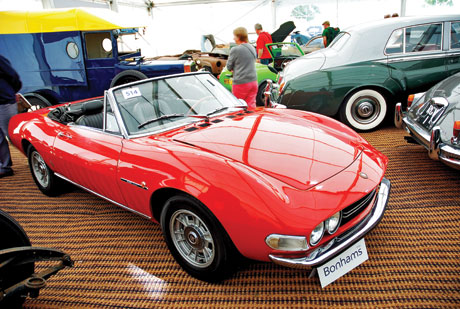
The foibles of “production” car racing and homologation rules have given rise to some rather interesting machinery over the years. Nutty Plymouth Superbirds and road-going Ford GT40s are at one end of the spectrum, and Ferrari’s first V6 engine is at the other.
Alfredo “Dino” Ferrari envisioned the V6 as an ideal Formula 2 engine before his untimely death in 1956. But the engine didn’t come to fruition until nearly a decade later. By then, there was simply no way that Ferrari could build a sufficient number of Dino 206 GTs to successfully homologate the engine for racing.
Il Commendatore then turned to Fiat to find another outlet for the brilliant 2-liter, DOHC V6 engine.
As it happened, Fiat was looking for a flagship GT to replace the 2300, and the Ferrari-designed V6 was ideal in terms of power output and cachet for the new Fiat Dino.
Two body designers
Like Alfa Romeo had done a decade before with the Giulietta, Fiat employed Bertone and Pininfarina to design entirely different coupe and spider bodies. While both were attractive, the Fiat Dino coupe looked much like a number of small coupes then on the market, including cars as diverse as Opel and Glas.
On the other hand, the Fiat Dino spider was quite striking, with the same round taillights and highly arched fenders as the 206/246 Dino. Of the two, it was far more Ferrari-like (arguably even more so than the 275 GTS).
The original 2-liter Fiat Dinos had about 160 horsepower and a rather basic rear suspension consisting of a live rear axle and leaf springs. Later 2.4-liter cars put out over 170 horsepower and had more sophisticated independent rear suspensions. In a first for Ferrari, Fiat built the engines in Turin rather than in Ferrari’s Maranello plant.
Contrary to rumor, there were no differences between the engines that went into Fiat Dinos and the engines supplied to Ferrari for 206 and 246 Dinos.
The view from behind the wheel of the spider was not unlike an upmarket Fiat 124 spider, with lovely wood trim and plenty of black-rimmed Veglia gauges. The coupe added even more wood and a whopping seven-gauge instrument panel in comparison to the spider’s six gauges.
Beware of rust monsters
Of the pair, the spider was decidedly more sporting, owing to its lighter weight. The coupe was more rigid and made a nicer tourer. And although less agile, the coupe’s handling was certainly benign, and it even understeered a bit near the limit. Even the 2-liter cars with a live rear axle rode pleasantly.
The seats were comfortable, but the driving position was typical Italian, with the steering wheel raked towards the dash, which encourages an arms-out posture. The 2.4-liter spider was the best performer, as it is capable of 0-60 mph runs below 8 seconds. The mechanical noises are sublime.
Like any Italian car of this vintage, the Dino was rust-prone in the extreme, with fenders, door bottoms and jacking points of particular concern. Body panels and trim bits for the coupe or spider are nearly extinct, so purchasing any car missing pieces or in need of significant rust repair is sheer folly.
Similarly, while the car carries Fiat badging, service and repair to the drivetrain carries a Ferrari price tag. Accordingly, it’s best to steer clear of cars with uneven compression, smoking or low oil pressure. Worn synchros or noise from the ZF 5-speed are signals of an expensive rebuild.
Not rare, but still special
By Ferrari standards, the Fiat Dino is anything but rare. Total production was 7,803 cars, with 26% spiders and 74% coupes. Overall, only 36% were 2.4-liter cars. The survival rate of the spider must surely be greater, as one rarely sees coupes.
In terms of ultimate collectability, the 2.4-liter spider seems to be well in front. Unlike the 2-liter cars, the 2.4s were assembled in Maranello at the same time as the 246 Dino. Thus, those who argue that it’s as much a Ferrari as the 246 GTS would seem to be correct. Nevertheless, it’s the Fiat badge that holds the car back. This is odd, as it certainly doesn’t bother collectors interested in a Fiat 8V.
Eventually, the car may be accepted for what it is, and owners will cease putting Ferrari badges and Scuderia shields on the fenders and realize what special cars these are in their own right.